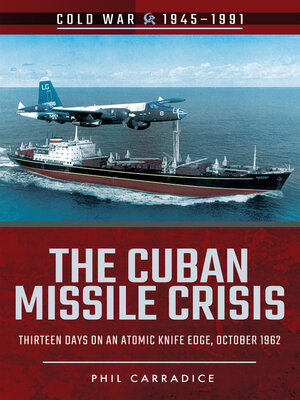The Cuban Missile Crisis
ebook ∣ Thirteen Days on an Atomic Knife Edge, October 1962 · Cold War, 1945–1991
By Phil Carradice

Sign up to save your library
With an OverDrive account, you can save your favorite libraries for at-a-glance information about availability. Find out more about OverDrive accounts.
Find this title in Libby, the library reading app by OverDrive.



Search for a digital library with this title
Title found at these libraries:
| Library Name | Distance |
|---|---|
| Loading... |
This gripping Cold War history chronicles the events that brough the world to the edge of nuclear war—and the political drama that averted disaster.
The Cuban Missile Crisis of 1962 was the closest the world has yet come to nuclear war, a time when the hands of the Doomsday Clock really did inch towards the witching hour of midnight. By placing nuclear missiles on the Caribbean island of Cuba where, potentially, they were able to threaten the eastern seaboard of the USA, Nikita Khrushchev and the Soviet Union escalated the Cold War to a level that everyone feared but had never previously thought possible.
In a desperate and dangerous game of brinkmanship, for thirteen nerve-wracking days Premier Khrushchev and President Kennedy held the fate of the world in their hands. Kennedy, in particular, wrestled with a range of options – allow the missiles to stay, launch an air strike on the sites, or invade Cuba. In the end, he did none of these. But the solution to one of the deadliest dilemmas of the twentieth century proved to be a brave and dramatic moment in human history.
The Cuban Missile Crisis of 1962 was the closest the world has yet come to nuclear war, a time when the hands of the Doomsday Clock really did inch towards the witching hour of midnight. By placing nuclear missiles on the Caribbean island of Cuba where, potentially, they were able to threaten the eastern seaboard of the USA, Nikita Khrushchev and the Soviet Union escalated the Cold War to a level that everyone feared but had never previously thought possible.
In a desperate and dangerous game of brinkmanship, for thirteen nerve-wracking days Premier Khrushchev and President Kennedy held the fate of the world in their hands. Kennedy, in particular, wrestled with a range of options – allow the missiles to stay, launch an air strike on the sites, or invade Cuba. In the end, he did none of these. But the solution to one of the deadliest dilemmas of the twentieth century proved to be a brave and dramatic moment in human history.







